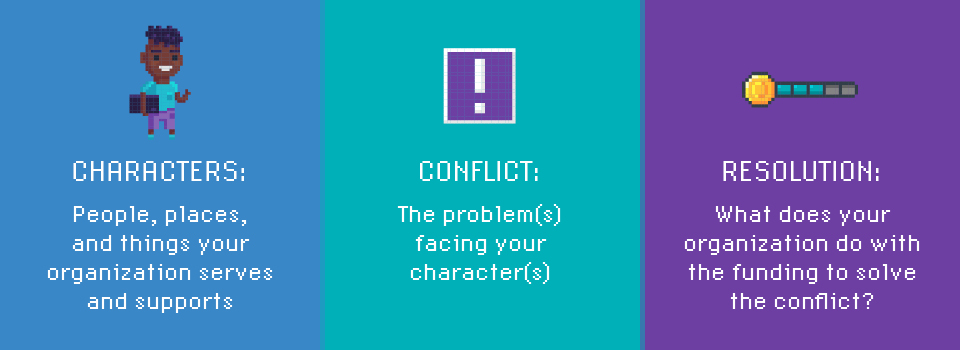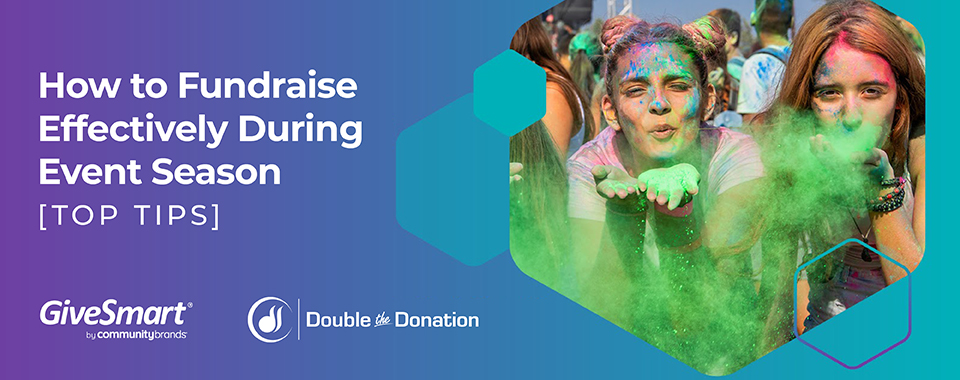Jul 31, 2023
Level Up Your Storytelling

Effective storytelling is imperative to achieving success with your fundraising strategy; it creates deeper, genuine connections with your loyal and impassioned supporters.
Great storytelling captures interest because it makes your cause and constituents feel relatable, real, and urgently in need. To convey your nonprofit’s stories, you need to include three basic elements: characters, conflict, and resolution.

You can share your stories on social media, during events, via email, mailings, on fundraising home pages, and via third parties. Even with limited resources and time, you can press start and improve the way you share your mission and successes to inspire donor engagement and giving.
Level 1: How to Capture Donors’ Attention in a Noisy Environment
To stand out, you need to go beyond the buzzwords of your mission and take it a step further. Everyone is looking for a cure, to clean, to help, to end, etc. But what does an investment in your organization really do for the community? Why should your potential donors care?
Some questions you can ask yourself as you’re forming your storyboards:
- What does a cure/help/end actually mean?
- What outcomes and data can we share?
- What is possible for our beneficiaries because we funded a medicine/helped/ended?
- What isn’t possible for our community because we didn’t fund a program?
- How can donors, volunteers, and sponsors individually make an impact?
Too often, nonprofits lead with the ask. To break through, and before you ask for money, you must demonstrate your organization’s value and how donors are needed to make an impact. You need to draw people into why your organization specifically matters and is deserving of support.
Donors who feel connected, needed, and appreciated give.
Level 2: Three Key Components of Authentic Storytelling
Cast Your Donor as the Hero
When potential donors see themselves as a part of your story, they are more likely to give. That not only means creating a connection to your characters and conflict, but your organization should highlight others who have been a part of the resolution.
Some examples of highlighting donors and volunteers include:
- Day in the life social media takeover by a board member, donor, or volunteer
- Article or mention in a volunteer’s or donor’s internal company newsletter/communication
- Sponsor-led/hosted recruitment happy hour or breakfast
- Volunteer “corner” in your newsletter
- Call night where involved supporters recruit other walk participants, gala attendees, etc.
- Email “from” a high-level volunteer that encourages participation
- Regular updates to your fundraising landing pages with videos and testimonials
In all of these instances, the donor or volunteer sharing or being highlighted should share the impact your organization has had on them (better company culture, more family time, etc.).
One of the top reasons people don’t give again is that they did not feel their donations were needed. Help donors also see themselves as a true part of the resolution, and you will gain dedicated supporters.
Showcase Your Journey and Dedication
Share your accomplishments! People will be motivated by what is possible now because of your past hard work.
It can be harder (and take longer) to convey what bad isn’t happening because of your organization, but with data and tying your narrative to the present, you can convey why continued investment in your mission matters.
Over the Rainbow Housing (OTR) does a good job of this consistently, in particular with their Kindness Tag campaign. Without the Kindness Tag campaign, many of their residents would face a diminished quality of life and needlessly added stressors. The Kindness Tag campaign was born by residents, but it is only possible because of the enriching community, culture, and programming OTR has built for its residents.
You can’t convey your organization’s growth in one snippet, but folding in what your culture and accomplishments have been does help demonstrate to donors why your mission is worthy of support.
Always be Trustworthy
People stop giving because they don’t know how their gift was used. Providing specific follow-up to donors from a particular event or campaign on what the impact of their dollars was inspires continued loyalty.
Trustworthiness is only a part of genuine relationships. That means acknowledging shortcomings, in tandem with celebrating accomplishments. Part of telling stories is also sharing the hard parts.
What programming was cut when you didn’t hit a goal? What research was stopped because it didn’t show promise? What was able to be turned around because of your donors’ investments? What rising costs are interfering with your bottom line?
If you share the downs alongside the ups, you create a genuine narrative that deepens your organization’s relationships with its supporters.
Level 3: Cheat-Codes: Tips to Craft Your Next Great Story
Branding
Branding exercises are an investment of time, but having consistent branding and messaging is key to storytelling.
People only spend seconds looking at something when they scroll through social media and barely glance at an e-mail subject line before they actually read it. Without seeing your logo, people should know your visuals and words are from your organization. It goes beyond color choices and logo placement.
Your branding should be consistent, clear, and captivating. It should be true to your mission and values. While capturing all of that may feel harder than beating a game, you can take some small steps in refining your brand to make a lasting impression on your audience.
Design
Design takes a lot of talent and time. As you are looking to improve your graphics, social cards, newsletters, and other assets, Canva for nonprofits is a great place to find resources and tools to help with design. If you take the time to create templates, it is very easy for everyone on your team as well as your volunteers to share a consistent brand at every level.
Data
As you look at investing more time in crafting your stories, take a look at engagement data via email, social media, and surveys. Diving into the insights and learning what works and what doesn’t, can help you focus your resources where you can have the most impact.

Some questions to ask yourself as you dig into your engagement data:
- Do videos get more engagement?
- How did a social media takeover perform?
- What are people telling you via a survey on what they want to see more of?
- Are there seasonal shifts in traffic and engagement?
If you’re just getting started, we have a guide on Social Media Strategies for Nonprofits that you don’t want to miss.
Enablement
If you are involving your volunteers, donors, and sponsors in your storytelling plans, you have to provide them with enablement.
Providing not only scripting, a storyboard, sample posts, and talking points, but also giving them swag, social media frames, and more will elevate your narrative and keep everything on brand.
Achieve a high score with your audience and better engage your donors with better storytelling. Improving your narrative leads to fundraising success, increased donor retention, and improved donor stewardship. GiveSmart’s dynamic fundraising pages, communication tools, and included integrations help you make your mission a movement.
Related



